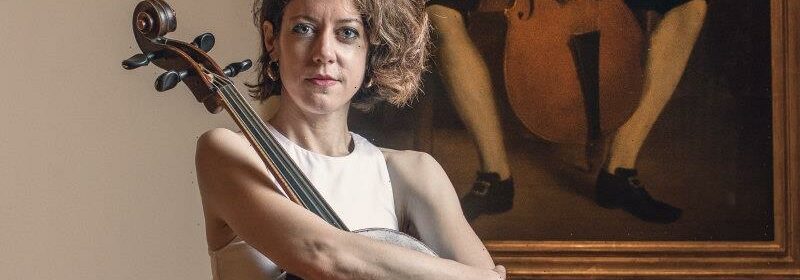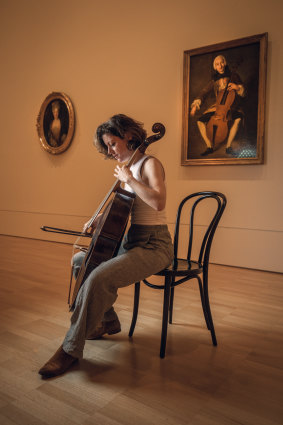How to get a rare instrument to tell you its story, and other fiddly questions

When Elinor Frey travels she faces a tough decision. Which of her seven instruments will she bring with her?
The cello soloist, baroque music specialist, teacher and researcher has a special interest in rare, not-often-heard period instruments – not only in preserving them, but playing them live so their sound isn’t lost to time.
Elinor Frey plays her violoncello piccolo alongside a portrait of cellist and composer Luigi Boccherini at National Gallery of Victoria.Credit:Scott McNaughton
On this trip, she will be playing both a cello and a violoncello piccolo, an instrument that is rarely seen and even more rarely heard.
Frey has five cellos and two instruments from the smaller viola da gamba family, each with their own distinct features. “I use them all a lot,” she says. “They are all different timbres, different colours, different stories. It keeps me on my toes, but it also means I spend so much money on strings – my strings budget is insane.”
Frey sees herself as a successor to the historically informed performance movement from the 1960s, but less didactic. “The idea of historical performance is not to ossify, or say this is the right way to play something forever, but to make a dynamic, evolving exploration of music and its possibility.”
“With music, if you add a quality you lose something else.”
She studies the past through different sorts of evidence – the music and instruments themselves, letters, treatises, documents, iconography, archaeology – to understand how composers and performers at the time might have thought about their culture and music and the sounds they might have heard from their instruments.
Musicologists like her, she says, are building on the previous generation, deepening their ideas with different priorities and sounds, and she hopes her students in turn will build on her ideas.
Part of her work, however, is putting theory into practice. Gut strings, which Frey uses rather than steel on all her instruments, are one important influence in a historical sound. “There’s a warmth in tone and colour, but mostly a speaking quality – less sustained, less smooth, more as if you’re saying words with all sorts of consonants, long, short, soft, sharp,” she says.
Baroque bows also aid a warmer, more resonant sound, but the most important factor, Frey insists, is her own mind.
Elinor Frey is an advocate for playing music using the period instruments for which it was written. Credit:Scott McNaughton
“If I play a modern cello the sound will be pretty close to my baroque cello, but the tone quality of the strings will be different and it lends itself to a different way of playing; I’ll feel I’m resisting its natural instincts. What’s in my head is the biggest thing. That’s what I hear, so I’m going to search for what I hear – the most important thing is a vision for the sound.”
In Melbourne, with the Australian Brandenburg Opera led by Paul Dyer, she will play four works by Italian Composer and cellist Luigi Boccherini on her “classical cello”, and a concerto by Sammartini on her violoncello piccolo, a three-quarter sized instrument tuned an octave below a violin.
When Frey developed her interest in baroque cello she had to learn many different instruments of different sizes, different tuning, different strings (one has five strings rather than four), to play at different music pitch, to use an underhand bow grip, adopt a different posture and learn different clefs – and that was just the start.
“My sense of virtuosity is not just playing high and fast, but also being flexible. I play as a soloist, or chamber music, or as continuo (helping the orchestral sound), so there’s more different kinds of skills that make it ever-changing,” she says.
Baroque instruments are more natural to the music of the time, the phrasing, the releasing, the speaking quality of the music, Frey says. “If the instrument naturally has those characters it brings the music alive in a beautiful and interesting way that is more connected to the inherent nature of the music.”
Preserving this historical sound is important not just for its own sake. “Music as an art form is not linear, it’s not like a computer, where it just gets better, more powerful, more memory and faster. With music, if you add a quality you lose something else. There are different advantages and drawbacks.”
Elinor Frey will be performing with the Australian Brandenburg Orchestra at Melbourne Recital Centre on March 2, 4 and 5.
A cultural guide to going out and loving your city. Sign up to our Culture Fix newsletter here.
Most Viewed in Culture
From our partners
Source: Read Full Article

